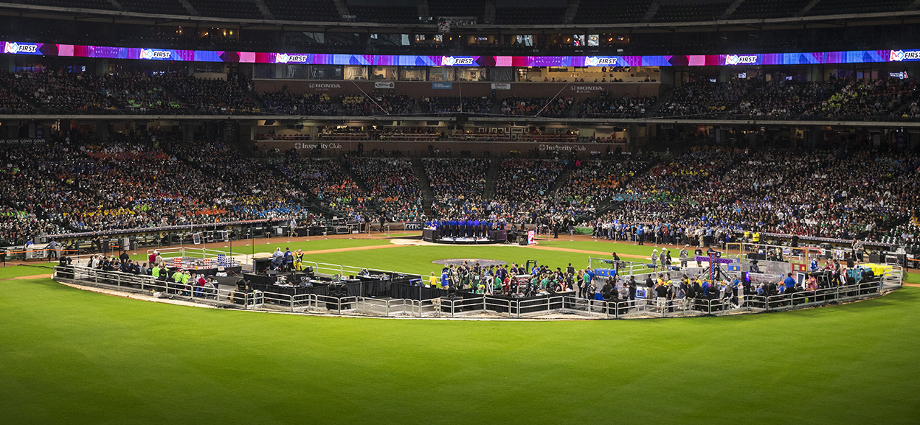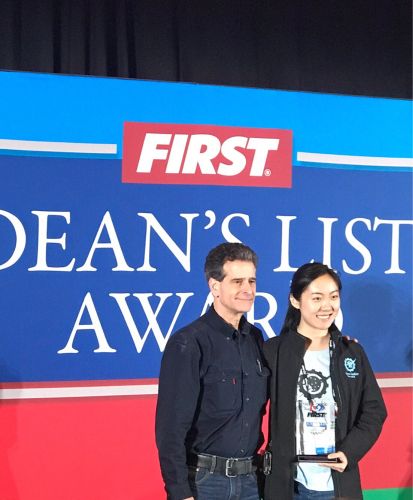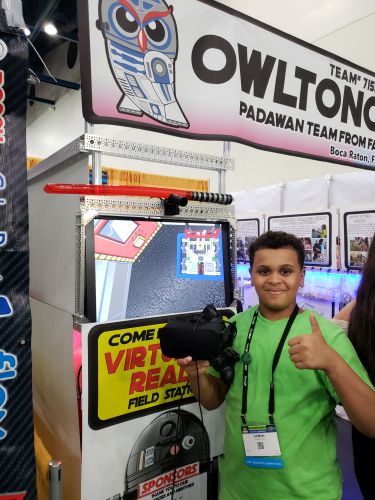Teamwork Makes Machines Work: Young Roboticists Power Up Their Peers at FIRST Robotics Championships
Jun 29, 2018 By Jennifer Deauville, NVIDIA

Thousands of cheering fans gather at Minute Maid Park in Houston for final matches during the 2018 FIRST Championship Presented by Qualcomm Incorporated.
Editor’s Note: This post was originally published on the blog of FIRST sponsor NVIDIA.
She’s only 17 years old, but Grace Lam already knows better than most one of the keys to success. It’s not just about having the best invention or beating opponents, it’s also having the heart of a collaborator.
Grace was rewarded for hers at the 2018 FIRST Championship, an annual student event that combines the thrills of gladiatorial sport with the braininess of applied science and technology.

FIRST founder Dean Kamen presents Grace her Dean’s List award.
Grace is a member of Space Cookies, an all-girls FIRST Robotics Competition team out of Palo Alto High School, in Northern California, and sponsored by the Girl Scouts and NASA. Space Cookies was one of more than 3,600 teams involving 90,000 total students from 27 countries who participated this year in the FIRST Robotics Competition.
During the event, high schoolers have six weeks to design and build robots to perform tasks against a field of competitors. They’re also expected to embody the idea of Coopertition – teams should help each other, even in the heat of battle.
With an eye toward increasing gender balance in the field, Grace, an NVIDIA intern last summer, has been busy teaching workshops for other FIRST students on the NVIDIA Jetson supercomputer and deep learning. She’s led a Deep Learning Institute lab on image classification with DIGITS and plans to host two more labs over the summer.
“During my NVIDIA internship, I had great mentors and resources,” said Grace. “But I realized that many students don’t have the same access I did and don’t know how to get started with deep learning. AI and deep learning is critically important for robotics, not only for FIRST but the industry in general.”
For her leadership and passion for giving back, Grace earned the prestigious Dean’s List Award, presented by FIRST cofounder Dean Kamen, who’s famous for inventing what became the Segway.
Space Cookies on an AI Mission
The FIRST Robotics Competition’s theme this year — POWER UP — focused on characters trapped in an arcade game, where alliances must be forged to defeat the boss standing between players and their escape.
Student-built robots zip around the field collecting power cubes and placing them on plates to control switches and tip scales in their favor. Bots that deliver cubes to their human counterparts earn valuable power-ups.
After training their neural network on 6,000 images, the Space Cookies team’s bot used the fast onboard processing of the Jetson TX2 to identify cubes regardless of scale, orientation, exposure and surroundings.
NVIDIA backed 104 FIRST teams — twice the number as last year — from six countries, including Canada, Chile, Japan, Mexico and Turkey. Of those, 43, including Space Cookies, made it to the coveted world championships, held this year in Houston and Detroit.
Lending a Helping Hand, One Workshop at a Time
Readying a robot for the competition is a daunting challenge given the six-week build limit and the fact that many teams don’t have access to a physical field to practice on.
Enter Arman, a seventh grader on the Owltonomous team from Alexander D. Henderson University School, a middle school located on the campus of Florida Atlantic University, in Boca Raton.

Arman with his VR field station.
Arman has an ambitious history with the competition. When he was in the second grade, he wanted to join a FIRST Robotics Competition team but discovered he wasn’t old enough.
Last summer, determined to contribute, Arman created a simulated version of a regulation FIRST competition playing field in VR in the Unity game engine. He built it in just three weeks.
In the VR simulator, players can see the exact position and orientation of their bot. A camera feed of the VR field as seen by the robot is streamed to an NVIDIA Jetson.
This allows teams who don’t have access to an actual field to develop software approaches and algorithms to determine the location of their robot within the context of the field and game elements.
“My goal is to give this to all FIRST teams across the globe, so they can practice without having to use an actual robot,” said Arman. “I’m also planning a multiplayer version of the game where each team can put in their unique robot as well as an AI version to compete online against other teams.”
The spirit of Coopertition is strong with Arman and Grace, as they help advance the work of a new generation of robotics innovators. It’s also a reminder that even in the face of fierce competition, compassion and teamwork should always come FIRST.
Find out how you can support the next generation of STEM innovators.
If you have an inspiring story or piece of wisdom that you’ve picked up through your experiences in the FIRST community, please reach out to us at inspire@firstinspires.org and inquire about becoming a guest contributor for Inspire.


